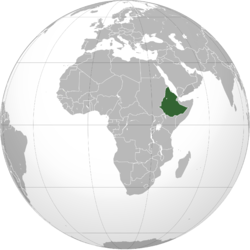Dergue
| Provisional Military Government of Socialist Ethiopia | ||||||||||
| የኅብረተሰብአዊት ኢትዮጵያ ጊዜያዊ ወታደራዊ መንግሥት (Amharic) ye-Hebratasabʼāwit Ītyōṗṗyā Gizéyāwi Watādarāwi Mangeśt |
||||||||||
|
||||||||||
|
Anthem Ītyoṗya, Ītyoṗya, Ītyoṗya, qidä mī ኢትዮጵያ, ኢትዮጵያ, ኢትዮጵያ ቅደሚ Ethiopia, Ethiopia, Ethiopia be first |
||||||||||
| Capital | Addis Ababa | |||||||||
| Languages | Amharic | |||||||||
| Government | Marxist–Leninist military junta | |||||||||
| Chairman | ||||||||||
| • | 1974 | Aman Michael Andom | ||||||||
| • | 1974–1977 | Tafari Benti | ||||||||
| • | 1977–1987 | Mengistu Haile Mariam | ||||||||
| Legislature | Shengo | |||||||||
| Historical era | Cold War | |||||||||
| • | Coup d'état | 12 September 1974 | ||||||||
| • | Monarchy abolished | 21 March 1975 | ||||||||
| • | Constitution adopted | 22 February 1987 | ||||||||
| Area | ||||||||||
| • | 1987 | 1,221,900 km2 (471,800 sq mi) | ||||||||
| Population | ||||||||||
| • | 1987 est. | 46,706,229 | ||||||||
| Density | 38/km2 (99/sq mi) | |||||||||
| Currency | Ethiopian birr (ETB) | |||||||||
| Calling code | +251 | |||||||||
|
||||||||||
| Today part of |
|
|||||||||
The Derg, Common Derg or Dergue (Ge'ez: ደርግ, meaning "committee" or "council") is the short name of the Coordinating Committee of the Armed Forces, Police, and Territorial Army that ruled Ethiopia from 1974 to 1987. It took power following the ousting of Emperor Haile Selassie I. Soon after it was established, the committee was formally renamed the Provisional Military Administrative Council, but continued to be known popularly as "the Derg". In 1975, it formally abolished the monarchy and embraced Communism as an ideology. Its regime eventually became formally known as the Provisional Military Government of Socialist Ethiopia. Between 1975 and 1987, the Derg executed and imprisoned tens of thousands of its opponents without trial. In 1987 Mengistu Haile Mariam, its chairman since 1977, abolished the Derg and replaced it with the People's Democratic Republic of Ethiopia. However, Mengistu and the surviving members of the Derg dominated the new government. After years of warfare by a coalition of ethnic-based parties, Mengistu was overthrown in 1991.
After the February 1974 popular revolution, the first signal of any mass uprising was the actions of the soldiers of the 4th Brigade of the 4th Army Division in Nagelle in southern Ethiopia. They were unhappy about the state of their food and water, and arrested their brigade commander and other officers. When the government sent the commander of the ground forces, General Deresse Dubala to treat with the rebels, they held him and forced him to eat their food and drink their water. Similar mutinies took place at the air force base at Debre Zeit, on 12 February, and at Second Division at Asmara on 25 February. It was these protests that gave rise to a general armed forces uprising.
The Coordinating Committee of the Armed Forces, Police, and Territorial Army, or the Derg (Ge'ez "Committee"), was officially announced 28 June 1974 by a group of military officers. This was done in order to maintain law and order, due to the powerlessness of the civilian government following widespread mutiny in the armed forces of Ethiopia earlier that year. Its members were not directly involved in those mutinies (as far as anyone knows), nor was this the first military committee organized to support the administration of Prime Minister Endelkachew Makonnen. Alem Zewde Tessema had established the Armed Forces Coordinated Committee 23 March. Over the following months, radicals in the Ethiopian military came to believe Makonnen was acting on behalf of the hated feudal aristocracy. When a group of notables petitioned for the release of a number of government ministers and officials who were under arrest for corruption and other crimes, three days later the Derg was announced.
...
Wikipedia




